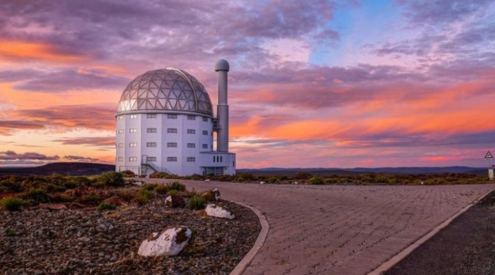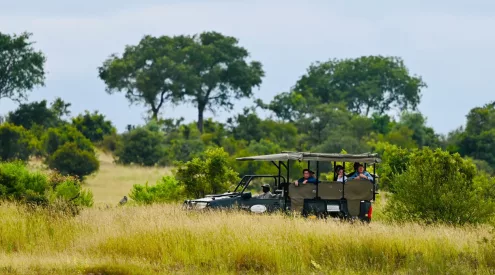Trees shelter us in their shade in hot and dry summers, give us oxygen to breathe and are the picturesque silhouettes in your landscape shots featuring those incredible African sunsets. They’re the refuges leopards leap to and lounge, and the places to which elephants and giraffes crane their trunks and necks to indulge in their produce.
1. Baobab (Adansonia)
The baobab is a central motif in African mythology, and considered by some to be the ‘tree of life’. The baobab is a great source of vitamin C, and has become a trendy superfood ingredient to feature in various beverages on upmarket supermarket shelves and restaurant menus now. Unfortunately, this towering African icon, which can measure up to 30m in height, is at risk of extinction, as baobabs are sadly rumoured to be dying in South Africa. The best place to see them in SA would be in Limpopo. Getaway Gear Editor Matthew Sterne even went on the ultimate baobab road trip, where he visited eight different locations in the province, as well as parts of Kruger and Botswana, to glimpse the giant trees before they die.
View this post on Instagram
2. Marula (Sclerocarya birrea)
This fruitful tree is what many of us associate with the creamy liqueur, Amarula. Another fabled African tree, marula trees have eight times as much as Vitamin C as oranges (and more than the baobab contains), and their nut-like seeds are edible and can be used in cooking. Some sources even claim you can substitute coffee for the dried skin of marula fruits. The funniest story you may have heard about marula trees and their fruit is the one of elephants, whose long trunks help them reach high up into trees to pick the fruit, getting drunk off the fermented fruits still hanging from the tree.
View this post on Instagram
3. Mopane (Colophospermum mopane)
This leguminous tree has a few other names worth mentioning: the butterfly tree, for the winged appearance of its leaves; the balsam tree, for its fragrant smell, and the turpentine tree, so-named perhaps for the same reason. Its hard and termite-resistant wood is perfect for making furniture with and creating woodwind instruments. Mopane moths make use of the tree to house its larvae, and elephants, impala and kudu enjoy eating the fragrant leaves. Mopane trees may be found in hot and dry areas in South Africa, Namibia, Botswana, and Zimbabwe.
View this post on Instagram
4. Quiver tree (Aloidendron dichotomum)
Also known as the Kokerboom in Afrikaans, the quiver tree’s sharp leaves which point upwards towards the sky are sort of like a quiver holding arrows, and, in fact, the indigenous bushmen used to make quivers from this tree to house their arrows. Being a tree, it’s also one of the biggest aloe plants, found in the Northern Cape in South Africa, and in Keetmanshoop, the first town you reach upon entering Namibia from SA.
View this post on Instagram
5. Whistling Thorn (Vachellia/Acacia drepanolobium)
It is said that when the wind blows over these East African trees’ thorns, it produces a pitchy, whistling sound. The tree, which like many others on this list is related to the acacia family, has an interesting symbiotic relationship with four ant species. The bulbous spheres at the base of the thick thorns which contain a sweet nectar protect the tree from roving large herbivores if the intimidating thorns don’t do the trick.The gum of the whistle-thorn tree can be used to make glue.
View this post on Instagram
6. Sausage (Kigelia africana)
These tropical African trees can be found a bit further afield on the continent in Eritrea, the south of Chad, Senegal, Namibia, and the northern parts of South Africa, as well as parts of India. The flowers are pretty, open red blooms, but the fruit, the reason behind the tree’s name, are rather unusual. They really do look just like sausages, and hang downwards from the tree in tube-like cases. Beware, though: the fruit, when fresh, is quite poisonous and can act as natural strong laxative if consumed. However, when dried out or fermented, it is perfectly safe to eat. Sausage tree by-products include a fermented alcoholic drink popular in Kenya. The tree has anti-malarial properties too, and many products are derived from it which can heal the skin. Afrikaners also call it the worsboom, no doubt agreeing about the fruit’s sausage-like appearance.
View this post on Instagram
7. Yellowwood (Podocarpus latifolius)
These large evergreens comprise South Africa’s national tree, or rather the ‘Real Yellowwood’ does. In SA, they’re found in various parts of Limpopo up north, on the Cape Coast further north, and can even on Table Mountain – now that’s iconic. On the Garden Route between the Western- and Eastern Cape close to Knysna, the Tsitsikamma has a few trees dating back 500-600 years, with trunks an impressive 40m wide. Outside, they can be found in Zimbabwe.
View this post on Instagram
8. Acacia (Acacia s.l.)
There are about 28 species of Acacia in Southern Africa alone, but this tree is found in a few other continents across the world. In Africa it is found in Nigeria, Niger, Senegal, Kenya, Ethiopia, and Egypt, and is a favourite meal of giraffes, whose tough black tongues are able to withstand the large thorns. Acacias can be used for their gum and to make perfume, and are also known as mimosas and wattles.
View this post on Instagram
9. Fever Tree (Vachellia xanthophloea)
This subtropical tree is also known as its literal translation in Afrikaans as the koorsboom. It is so-named because it grows in warmer climes and swampy regions and was once thought to cause or spread malaria, but now we know better. Many animals and birds enjoy its leaves, and the tree can be found in throughout South Africa (Northern Province, Mpumalanga, KwaZulu-Natal) as well as many of our African neighbours, from Botswana to eSwatini (formerly Swaziland) to Mozambique to Zimbabwe and Malawi. It is a truly classic feature of African landscapes. A unique feature of this tree is that it doesn’t photosynthesise through its leaves, but through its bark.
View this post on Instagram
10. Spekboom (Portulacaria afra)
No, it’s not a bacon tree, but you can eat it… sort of. Spekbooms grow in shrubs and even little trees. The small, succulent, fleshy leaves are edible and have a lemony taste that could pair well in a salad. This plant is more commonly known by its Afrikaans name here in South Africa, but is also commonly known as Porkbush or Elephant bush elsewhere. What’s all this reference to the crispy, salty favourite, bacon about? Well, it could stem from the fact that you can eat it, or its namesake in English. Its name may also be a mispronunciation of its scientific name, if you replace the ‘p’ in Portulacaria with a ‘k’.
These are very hardy plants and grow in arid conditions like the Karoo. You can find them while driving up to Camdeboo National Park.
View this post on Instagram
Featured image: Melanie van Zyl

















